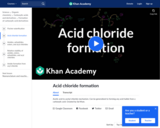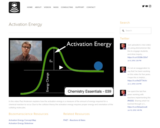
The general idea behind the word 'abstract'
- Subject:
- Algebra
- Mathematics
- Material Type:
- Lesson
- Provider:
- Khan Academy
- Author:
- Sal Khan
- Date Added:
- 09/22/2013

The general idea behind the word 'abstract'

Calculating the acceleration of a Porshe

What is the acceleration due to gravity at the space station

Using what we know about takeoff velocity and runway length to determine acceleration

Attempting a demonstration with hydrogen peroxide, The Professor stumbles over an alternative!

This video is from the Khan Academy subject of Science on the topic of Cosmology and astronomy and it covers Accreting mass due to gravity simulation.

Simple example of accrual accounting

How and why a central bank would build foreign currency reserves

Paul Andersen explains how acid-base chemistry can be understood in terms of equilibrium. Water is present in all acid-base chemistry and is amphoteric in nature. The Ka and Kb values can be used to determine the strength of an acid or a base. Titrations can be used to student neutralization reactions between strong and weak acids and bases.

The video resource "Acid-Base Reactions in Solution: Crash Course Chemistry #8" is included in the "Chemistry" course from the resources series of "Crash Course". Crash Course is a educational video series from John and Hank Green.

Using acid-base titration to find mass of oxalic acid

Acetic Acid to Acetyl Chloride mechanism. Can be generalized to forming any acid halide from a carboxylic acid

Paul Andersen explains pH as the power of hydrogen. He explains how increases in the hydronium ion (or hydrogen ion) concentration can lower the pH and create acids. He also explains how the reverse is true. An analysis of a strong acid and strong base is also included.

Mechanics of a share-based acquisition

Actinium is element number 89, and first of the actinide series. This video is one of the 118 clips included in the periodic table of elements themed collection created by Brady Haran and the University of Nottingham in the UK.

See how muscle cells in the heart contract by allowing Calcium to flow inside and bringing along some positive charge with it! Rishi is a pediatric infectious disease physician and works at Khan Academy.

Find out how the pacemaker cells use the movement of sodium, calcium, and potassium to get your heart beating! Rishi is a pediatric infectious disease physician and works at Khan Academy.

See how Renin and ACE work to cut Angiotensinogen down to size! Rishi is a pediatric infectious disease physician and works at Khan Academy.

In this video Paul Andersen explains how the activation energy is a measure of the amount of energy required for a chemical reaction to occur. Due to the collision theory the activation energy requires proper energy and orientation of the colliding molecules.

Exploring the actual weightings for the CPI-U basket of goods